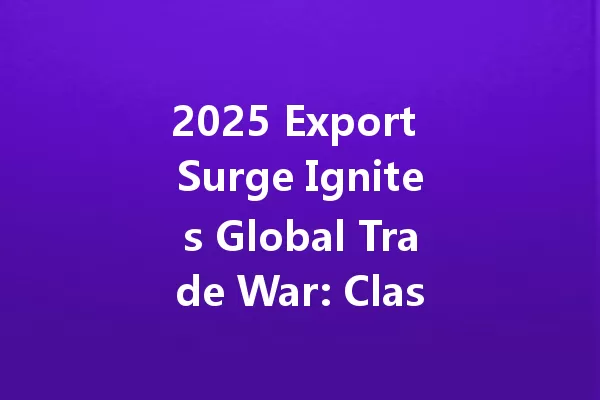
The Catalysts Behind the 2025 Export Boom
Green Tech and Semiconductor Dominance
The 2023-2025 global export surge has been primarily fueled by aggressive investments in green technology and semiconductor manufacturing. Countries like China, the U.S., and Germany have allocated over $1.2 trillion combined to subsidize solar panel, EV battery, and advanced chip production. For instance:
This race has created oversupply in key markets, with global lithium-ion battery production capacity now exceeding demand by 18%.
| Country | Green Tech Subsidies (2025) | Semiconductor Export Growth |
|---|---|---|
| China | $580B | +67% |
| United States | $320B | +41% |
| EU | €260B | +29% |
Trade Barriers and Retaliatory Measures
Tariff Escalation Patterns
The U.S. imposed 45-60% tariffs on Chinese EVs in Q1 2025, triggering Beijing’s 30% levy on American agricultural drones. Key developments include: 
Supply chain data reveals a 14-18 week delay for cross-Pacific container shipments, up from 6-8 weeks in
Sector-Specific Fallout
Automotive and Electronics Industries
Auto manufacturers face a 25-30% cost increase for EV components due to nickel and cobalt trade restrictions. The electronics sector reports:
Taiwan’s TSMC recently warned that 2025-2026 chip allocation quotas could force automakers to cut production by 3.5 million vehicles globally.
Geopolitical Flashpoints
South China Sea Shipping Lanes
With 35-40% of global trade passing through the South China Sea, naval blockades and insurance premium hikes (up 220-300% since 2024) have forced rerouting via Indonesia’s Lombok Strait. This adds 7-10 days to Asia-Europe transit times, increasing perishable goods losses to $12-15 billion annually.
Major shipping alliances like Maersk and MSC now require $2-3 million security deposits for high-risk routes, disproportionately affecting SMEs.
| Trade Route | 2023 Transit Days | 2025 Transit Days | Cost Increase |
|---|---|---|---|
| Shanghai-Rotterdam | 28 | 38 | +55% |
| Los Angeles-Tokyo | 15 | 22 | +40% |
The ripple effects of trade conflicts have fundamentally reshaped global shipping dynamics. Container ships that previously completed cross-Pacific routes in 6-8 weeks now face 14-18 week delays due to layered customs inspections and retaliatory port restrictions. This congestion snowball has forced carriers to implement 35-40% surcharges on priority bookings, with refrigerated container rates jumping from $8,000 to $14,000-$18,000 per unit since late
Rerouting strategies bring their own complications – vessels avoiding the South China Sea now add 7-10 days through Indonesia’s Lombok Strait, creating a $12-15 billion annual hemorrhage for perishables like Chilean salmon and Thai durians. Marine insurers have compounded the crisis by hiking premiums 220-300% for routes near geopolitical hotspots, while demanding 90-120 day upfront payments instead of the traditional 30-day terms. Smaller exporters report spending 55-60% of product margins just covering logistics, compared to 25-30% pre-trade war levels.
### What countries are leading the green tech export surge in 2023-2025?
China, the United States, and the EU dominate green tech exports with $580B, $320B, and €260B in subsidies respectively. China's solar exports grew 48% year-over-year under its "Clean Energy 2025" plan, while U.S. semiconductor equipment shipments to Asia rose 32% through the CHIPS Act.
How have shipping costs changed due to trade war tensions?
Cross-Pacific container shipment delays increased from 6-8 weeks in 2023 to 14-18 weeks in
Asia-Europe routes via the Lombok Strait now take 7-10 extra days, causing perishable goods losses of $12-15B annually. Insurance premiums for high-risk routes surged 220-300% since 2024.
What industries are most affected by semiconductor shortages?
The automotive sector faces 25-30% cost hikes for EV components and potential production cuts of 3.5M vehicles in 2025-
Electronics manufacturers report 40% chip price spikes and 18-month AI processor delays, forcing 12% workforce reductions in South Korean display panel factories.
Are SMEs adapting to new trade barriers?
Over 120 multinationals relocated 15-20% of production hubs to avoid tariffs. However, SMEs struggle with Maersk/MSC's $2-3M security deposits for risky routes. Many now use 35-40% longer alternative shipping lanes, increasing operational costs by 55-60% on key routes.
内容结尾插入,支持HTML代码,如果不需要请删除